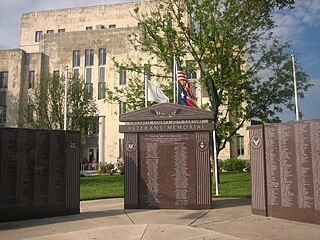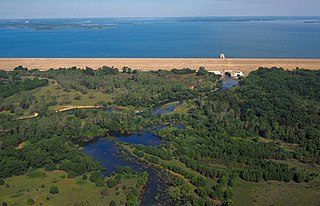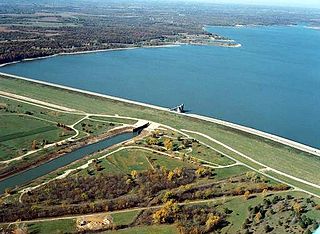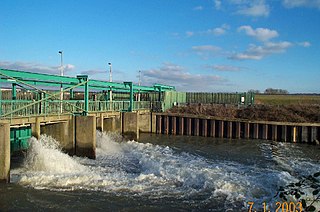Related Research Articles
Lake Kickapoo is a reservoir located on the North Fork Little Wichita River in the Red River Basin of Archer County, Texas. It is neighbored by Archer City, Texas and Wichita Falls, Texas which reside within the Central Great Plains ecoregion.

Childress County is a county located in the U.S. state of Texas. As of the 2020 census, its population was 6,664. The county seat is Childress. The county was created in 1876 and later organized in 1887. It is named for George Campbell Childress, the author of the Texas Declaration of Independence.

Lake Buchanan was formed by the construction of Buchanan Dam by the Lower Colorado River Authority to provide a water supply for the region and to provide hydroelectric power. Buchanan Dam, a structure over 2 mi (3.2 km) in length, was completed in 1939. Lake Buchanan was the first of the Texas Highland Lakes to be formed, and with 22,333 acres of surface water, it is also the largest. The surface of the lake includes area in both Burnet and Llano Counties. The lake is west of the city of Burnet, Texas.

Lewisville Lake, formerly known as Garza-Little Elm Reservoir, is a reservoir in North Texas (USA) on the Elm Fork of the Trinity River in Denton County near Lewisville. Originally engineered in 1927 as Lake Dallas, the reservoir was expanded in the 1940s and 1950s and renamed Lewisville Lake. It was built for flood control purposes and to serve as a water source for Dallas and its suburbs, but residents also use it for recreational purposes.

The Colorado–Big Thompson Project is a federal water diversion project in Colorado designed to collect West Slope mountain water from the headwaters of the Colorado River and divert it to Colorado's Front Range and plains. In Colorado, approximately 80% of the state's precipitation falls on the West Slope, in the Rocky Mountains, while around 80% of the state's growing population lives along the eastern slope, between the cities of Fort Collins and Pueblo.

Wilson Lake is a reservoir in the U.S. state of Kansas, on the border of Russell County and Lincoln County. Built and managed by the U.S. Army Corps of Engineers for flood control, it is also used for wildlife management and recreation. Several parks are located along its shoreline, including Wilson State Park.

Perry Lake is a US Army Corps of Engineers operated reservoir in northeast Kansas. Its primary purposes are flood control, water reserve for nearby areas and regional recreation. The lake is approximately 11,150 acres (45 km2) in size, with over 160 miles (260 km) of shoreline. Perry Lake's full multi-purpose pool elevation is 891.5 feet (271.7 m) above sea level. Perry Lake is located about 40 miles (64 km) west of Kansas City, just northwest of Lawrence, Kansas. Its close proximity to Kansas City, Lawrence, and the state capitol, Topeka, make it a very popular destination, with the nickname "Paradise on the Plains".

Lake Waco is a man-made reservoir located on the west side of Waco, in McLennan County, Texas. It provides water to several cities in the Waco Metropolitan Statistical Area, including Waco, Bellmead, Hewitt, Robinson, Woodway and others in the Cross Timbers and Prairies ecoregion of Texas. Lake Waco was formed by a dam built on the Bosque River basin. The lake has 79,000 acre-feet (97,000,000 m3) of water and is managed by the U.S. Army Corps of Engineers.

Wright Patman Lake is a reservoir in northeast Texas in the United States. The lake is a U.S. Army Corps of Engineers reservoir formed on the Sulphur River in Bowie and Cass counties by Wright Patman Dam. The reservoir provides flood control and water conservation for the communities downstream from the dam. The lake is also a popular recreational destination. The Bowie County side of the lake is part of the Texarkana metropolitan area.

The Addicks Reservoir and Addicks Dam in conjunction with the Barker Reservoir prevent downstream flooding of Buffalo Bayou in the city of Houston, Texas. Both reservoirs were authorized under the Rivers and Harbors Act of June 20, 1938, which was modified by the Flood Control Acts of 1938, 1954, and 1965. The US Army Corps of Engineers (USACE) completed construction of Addicks Dam and the outlet facility in 1948.
Comanche Creek Reservoir is a 3,275-acre (13.3 km²) impoundment located between Glen Rose, Texas and Granbury, Texas. The primary purpose is cooling for Comanche Peak Nuclear Generating Station. During full operation of both units of Comanche Peak, 2.2 million US gallons (8,300 m3) of water are pumped through the plant's main condensers from Comanche Creek Reservoir.

Cedar Creek Reservoir is a reservoir located in Henderson and Kaufman Counties, Texas (USA), 50 miles (80 km) southeast of Dallas. It is built on Cedar Creek, which flows into the Trinity River. Floodwaters are discharged through a gated spillway into a discharge channel that connects to the Trinity River.

The Lee Flood Relief Channel (FRC) is located in the Lea Valley and flows between Ware, Hertfordshire, and Stratford, east London. Work started on the channel in 1947 following major flooding and it was fully operational by 1976. The channel incorporates existing watercourses, lakes, and new channels. Water from the channel feeds the Lee Valley Reservoir Chain.

Dawson Forest is a 10,130-acre (41.0 km2) public-use forest located in Dawson County, Georgia, southwest of Dawsonville. It is owned by the city of Atlanta, but is considered a state forest, as it is managed by the Georgia Forestry Commission.

Thunder Creek is a river in the Canadian province of Saskatchewan. The watershed of Thunder Creek is within the semi-arid Palliser's Triangle in south-central Saskatchewan. It begins at small, man-made reservoir near Lake Diefenbaker and flows in a south-easterly direction towards the city of Moose Jaw and the Moose Jaw River. The Moose Jaw River is a major tributary of the Qu'Appelle River For most of its course, Thunder Creek follows a valley called the Thunder Creek meltwater channel that was formed over 10,000 years ago near the end of the last ice age.

Lake Tyler (West) is a man-made public water reservoir located south-east of Tyler, Texas, in eastern Smith County. While named after the town of Tyler (pop. 104,789), Lake Tyler is closer to the smaller cities of Whitehouse (pop. 7660) and Arp (pop. 970). Lake Tyler resides in the northern Neches River watershed, and was formed after the completion of Whitehouse Dam on Prairie Creek in 1949. The design engineer of the dam was T.C. Forrest (Now Forrest and Cotton, Inc.), and the earthfill dam was constructed to be 4,708 feet long, standing at a maximum height of 50 feet, with a width of 20 feet and a drainage area of 48 square miles, according to the Texas Water Development Board. Lake Tyler is found in the Piney Woods ecoregion of eastern Texas, a temperate coniferous forest hosting a great amount of biodiversity. Just to the east of the lake lies Lake Tyler East, created after the completion of Mud Creek Dam in early 1967. Just over a year later, in May 1968, the two lakes were connected by a canal to combine the water supply. Together, the two lakes have a combined safe yield of over 30 million gallons per day, and combine to encompass an approximate surface area of 4,714 acres, all maintained and operated by the city of Tyler to provide a source of public water to several surrounding communities.
Lake Tyler East is a reservoir on Mud Creek in the Neches River Basin of Smith County, Texas. It is neighbored by Whitehouse, Texas that is encompassed by Tyler, Texas which resides within the South Central Plains ecoregion.
Baylor Creek Reservoir also known as Baylor Lake is a reservoir located northwest of Childress, Texas. The unincorporated community of Carey and Lake Childress are situated to the east of the lake.
References
- 1 2 "Fishing Baylor Creek Reservoir". tpwd.texas.gov. Retrieved 2022-11-21.
- ↑ "TSHA | Lake Childress". www.tshaonline.org. Retrieved 2022-11-21.
34°28′05″N100°21′18″W / 34.46806°N 100.35500°W